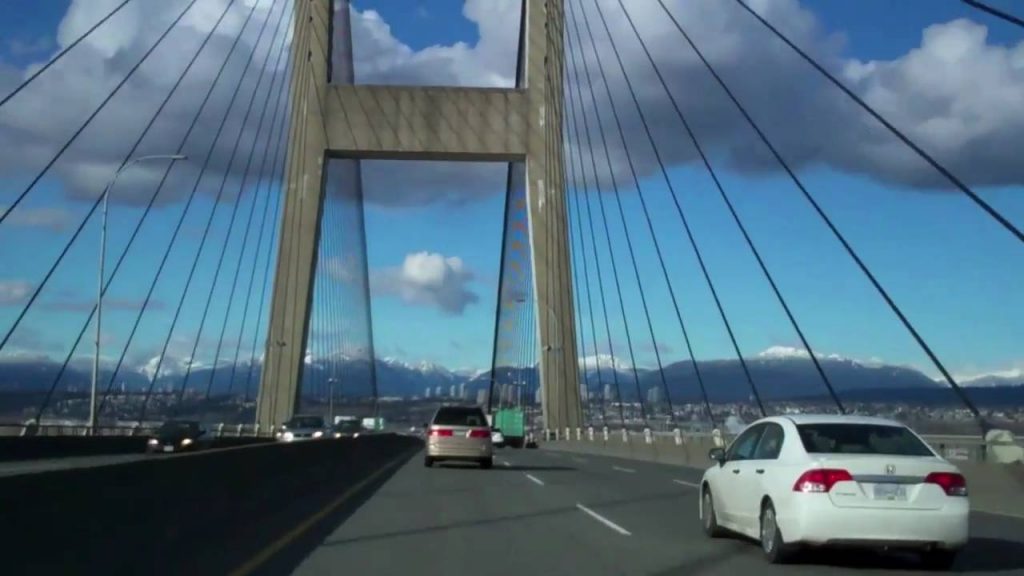
Delta: Today, the B.C. government unveiled a multi-step plan to help unclog congestion on the Alex Fraser Bridge and Highway 91 – starting with a new interchange at Highway 91 and 72nd, which will eliminate the final traffic signal on Highway 91 leading up to the bridge.
“Traffic demand on the Highway 91 corridor – and over the Alex Fraser Bridge – continues to grow as development in Surrey and Delta increases,” said Minister of Transportation and Infrastructure Todd Stone. “We need to get going on a fix, and get the traffic moving again. This is why we’ve kicked in an extra $10 million to move forward on a new interchange at Highway 91 and 72nd Avenue and developed a robust strategy to help cut the congestion on this key route, both in the short term and also the longer term.”
The Highway 91 corridor is a major trade corridor linked to Asia-Pacific trade. Commercial vehicles use this route every day to deliver goods to and from market. It’s important to make safety and efficiency upgrades to this key corridor to help reduce traffic queues for all travellers.
“As industry and population continues to grow, we are seeing more and more commercial vehicles going over the Alex Fraser, along with people on their morning and afternoon commutes,” said Delta North MLA Scott Hamilton. “All of this adds up to more time for people caught up in traffic, and we want to see people have more free time with their families instead. These solutions are key to unclogging the current traffic snarls at peak times.”
The B.C. government will:
- Move ahead with final planning to replace the Highway 91 and 72nd Avenue intersection with a new interchange. The B.C. government has committed an additional $10-million towards building the interchange, to get the project moving again. In total, the B.C. government is funding $20-million towards the $30-million future interchange. This interchange will eliminate the only remaining traffic signal on the Highway 91 corridor, a current choke-point for traffic. The plan is to provide the design details to the public in summer and tender the project subsequently, with construction to start in the fall.
- Immediately add three more tow trucks on standby and increase their on-site hours to clear up stalled or broken down vehicles as quickly as possible, to get them off the bridge.
- Increase the frequency of highway patrols, monitoring for congestion, incidents, safety, debris removal, with increased hours of coverage.
- The ministry will start an engineering review to look at:
- Installing a new counter-flow system on the bridge for the morning and afternoon traffic crunches; and
- Introducing an information system that will provide reliable travel information for the various Fraser River crossings at key decision points where motorists can adjust their travel patterns. Dynamic message signs will be installed at key locations on the highway network.
- In the longer term, the B.C. government will continue to work with the Government of Canada and Port of Vancouver to advance new interchanges at Nordel and Sunbury in the areas of Highway 91 and 17 to help further address congestion and move goods.
For more information on the upcoming interchange project at Highway 91 and 72nd Avenue in Delta, members of the community are invited to attend the following public information session: 3:30 p.m. – 8 p.m. on Thursday June 23, in the multi-purpose room in North Delta Rec Centre at 11415 84 Ave., Delta. There will be display boards with more information on the project, and ministry staff will be on hand to answer any questions.
Highway 91 supports approximately 8,000 and 9,000 vehicles per hour in the AM and PM peak hours respectively at the Alex Fraser Bridge. This traffic is comprised of approximately 6% truck traffic. During peak periods, demand on the bridge exceeds capacity and results in queues of two to three kilometres and delays of up to 30 minutes, and in excess of two to three hours when there’s a traffic incident.
Expanding the capacity of our transportation network is critical to improving safety, attracting new investment and supporting economic growth. As outlined in B.C. on the Move, the B.C. government will invest approximately $1 billion over three years to ensure our network has the capacity and reliability to meet transport and trade needs, with maximum safety and minimal delays.
The Province will continue to work with the Government of Canada to secure federal funding for highway-expansion priorities, as provincial investment can be enhanced by fully leveraging federal funding available under federal infrastructure programs.













